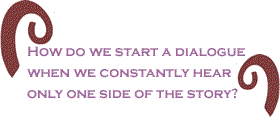Over the weekend, I saw the new film Miral
by director Julian Schnabel (The Diving Bell and the
Butterfly). I�ll start off by saying that overall,
it was well done. What was perhaps most noteworthy about
the film is that it told a story about the Israeli-Palestinian
conflict from the point of view of a Palestinian girl coming
of age, a voice we rarely hear.  And
to top it off, the film is based on a semi-autobiographical
book, Miral:
A Novel, by author-screenwriter
Rula Jebreal, Schnabel�s girlfriend. And
to top it off, the film is based on a semi-autobiographical
book, Miral:
A Novel, by author-screenwriter
Rula Jebreal, Schnabel�s girlfriend.
In
reality, Miral is the story of four women: Hind Husseini
(Hiam Abbass), who opens an orphanage and girls�
school for 55 displaced and wandering Palestinian children
in Jerusalem in the midst of the Arab-Israeli War; Nadia (Yasmine
Al Massri), a woman who faces alcoholism, abuse and imprisonment
after punching a Jewish woman on a bus for insulting her;
Fatima (Ruba Blal), a former nurse who received three life sentences
after attempting but failing to explode a bomb in a movie
theater, and Miral (Freida Pinto), Nadia�s daughter.
Miral is torn between her conservative and peaceful father Jamal (Alexander Siddig), and her love interest Hani (Omar Metwally),
a PLO activist.
Unlike
most U.S. media portrayals
of Arab people, this film presents Palestinians as everyday
human beings, in all their complexities. For example, the
children in the film demonstrated the full range of Palestinian
physical diversity, from fair-haired blond to Mediterranean
olive to black African. Palestinians and Israelis are known
to fall in love with each other and become couples. And
sometimes people and their actions are not so cut-and-dried.
It is easy to label someone a terrorist, and terrorist acts
were committed in Miral. At the same time, such labels
become blurred, as they are subject to nuance within the
context of a military occupation. For example, it was easy
for the main character to teeter on the edge between schoolgirl
and terrorist. Those who are oppressed
and displaced under occupation view their struggle as one
for liberation and self-determination. Some may seek peace
and reconciliation - and land - in furtherance of their
struggle. Others who view the occupier as a military adversary
who stole their land may find their answer through the barrel
of a gun and act accordingly. That is not to justify violence;
it is simply to provide the context for understanding what
human beings do when their backs are against the wall.
Through
its depiction of the Israeli occupation, Miral provides
a public service to viewers who are unexposed to it, unaffected
and unaware.  The
daily regimen of humiliating checkpoints, soldiers demanding
to see identification, and hostile religious settlers, backed
by troops, are a reality for Palestinians. The
daily regimen of humiliating checkpoints, soldiers demanding
to see identification, and hostile religious settlers, backed
by troops, are a reality for Palestinians.
Critics
have blasted the film as being one-sided,
as if that is a bad thing. One
heavy-handed critic even called Miral a
�slanderous and shameful piece of propaganda.� Everyone
has a point of view. And people deserve the space to tell
their own stories from their own point of view. Each day,
media interpret the experiences of groups of people through
distorted cultural lenses, without the input or consent
of their subjects. Stereotypes result.
When
they are not depicted as the hired help, African-Americans
and Latinos, not unlike Arabs, are stereotyped as terrorists
- urban terrorists and gangbangers who are a danger to society.
Additionally, blacks are depicted as welfare queens, and
Latinos are cast in the role of �illegal aliens� who cross
the border from Mexico to steal good
paying jobs picking oranges and busing tables. Asians become
the model minority, or human computers, with Asian women
stereotyped as the submissive China
doll or hyper-sexualized Dragon Lady.
And
rightwing media in the U.S. reduce Arab-Americans and Muslim-Americans
to shadowy figures, the �other� who would infiltrate society
and defile Christian values with their mosques, not to mention
blow up our cities. Did I mention that the President might
be one of them?
�The press is so powerful in its image-making role; it can make a criminal
look like he�s the victim and make the victim look
like he�s the criminal. This is the press, an irresponsible
press,� as Malcolm X once said. �If you aren�t careful,
the newspapers will have you hating the people who are being
oppressed and loving the people who are doing the oppressing.�

America needs exposure to more media images
of Arabs and others that are self-depictions, and yes, one-sided
representations of their reality. How do we start a dialogue
and transform ourselves and our condition when we constantly
hear only one side of the story?
I
highly recommend Miral, but that is not to say the movie is perfect. For instance, casting Indian actress Freida Pinto
of Slumdog
Millionaire fame in the role of Miral was at times
a mismatch. Moreover, surely an Arab actress was available.
Further, the viewer is left wanting to know more, more about
what happened to Miral. And although they are capable artists,
Vanessa
Redgrave and Willem Dafoe seem to serve no substantial
role other than the perfunctory Westerners in a film about
people of color.
Given
the paucity of positive images of Arabs out there, no single
film can be all things to all people. And no film by itself
can articulate the full breadth of the occupation or the
Mideast conflict. But this is a good
start.
BlackCommentator.com Executive Editor, David
A. Love, JD is a journalist and human rights advocate based
in Philadelphia, is a graduate of Harvard College and the University
of Pennsylvania Law School. and a contributor to The Huffington
Post, the Grio, The Progressive
Media Project, McClatchy-Tribune News Service,
In These
Times and Philadelphia
Independent Media Center. He also blogs at davidalove.com, NewsOne, Daily Kos, and Open Salon. Click here to contact Mr. Love.

|

